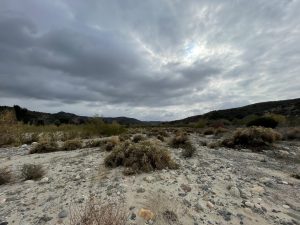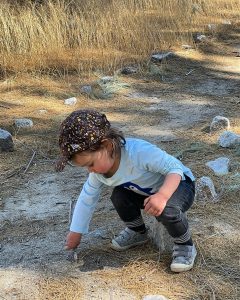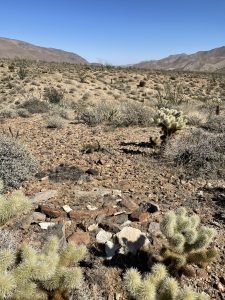You can’t discover unless you explore.
On a recent trip to the desert I snapped a picture of Charlotte, my two year old granddaughter midtrail, playing with a stick in the sand. She discovered she could make marks on the earth. Later that day, my wife and I drove out on a lonely dirt road, parked the car, and walked around just to see what we might find. On a certain knoll, we found an old home hearth, a mark on the earth made long ago amidst ancient desert pavement (naturally packed pebbles), in a place as primal as creation itself. Neither of these experiences revealed great explorations or notable discoveries, but both made lasting impressions.
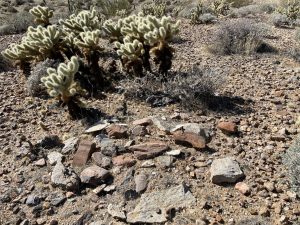
We believe that natural gardens are all about exploring and discovering, and that there’s no comparing them to the static, lifeless, ornamental landscapes so common almost everywhere; housing tracts, parkways, medians, commercial centers, street corners, industrial parks, model homes.
Natural gardens are places of inspiration because they are built from inspiring experiences like observing marks on the earth, drawing lines in the sand, and treading lightly on holy ground.
Current events, history, review, and notes
2020 gave us the summer that wouldn’t end and the winter that wasn’t to be. Here we are with spring 2021 at our doorstep and 4” rain in the gauge… total… for the season… not just two or so good storms… total… since last July… as in Total. (The rain year is measured from July through June.) Four inches marks the equivalent of 2 or 3 Deep Soak summer irrigations. We are in a drought year. March and April still hold some hope, with some rain in the long term forecast, but there is no denying the paltry winter.
Watering
If we don’t get a few good storms (1” or more per rain event) you will need to provide a Deep Soak to your garden every three weeks or so right through spring, summer and fall. For a quick review on the Tree of Life Nursery recommended watering technique called Deep Soaks & Refreshing Sprinkles see September 2020 Watering and Watering Guide.
Watch the weather forecasts and water accordingly. Essentially, you can do no harm by providing a Deep Soak to a winter dry garden. Give a good Refreshing Sprinkle any time you like since the sun is still low in the sky, but late afternoons are best.
Related to Watering
The reason we make such a big deal about cool season rain and summertime irrigation is simple. Native plants put on new growth in spring, and sometimes again in fall. Most are somewhat dormant during the coldest weeks of winter and the hottest months of summer.
Our winter rains charge the ground with valuable moisture during a season when the plants are not actually using the water for growing or cooling, but when the soils are cool and receptive. As the days grow longer and the soils begin to warm in spring, the plants grow beautifully as they find deep moisture from the winter rains. Then around May (Pre-summer), they start to ready themselves for a long dry summer by ceasing new growth, gradually changing their leaf orientation, forming thick waxy cuticles on their leaves, or even dropping a few leaves, which become natural mulch, preserving soil moisture in the root zone.
Our judicious summer irrigations essentially “lock in” the winter moisture and keep the plants more “garden worthy” than their counterparts out in the dry hills. By encouraging roots to grow into deep cool soils, we can include plant varieties which originate in colder wetter parts of our state, while at the same time allowing our southern California natives to look good all year. With irrigation, summer dormancy has less severe effects (esthetically speaking) than it would if the plants were growing on rainfall alone.
Come fall time, the days grow shorter and soils start to cool, making what many gardeners call a “second spring.” Plants grow again, some even bloom a little and they ready themselves for winter by opening up all the “windows” so a more gentle sunlight and new moisture can come in.
In summary, the most valuable moisture comes from winter rain, and when we don’t get enough we have to settle for the second best, irrigation… or choose to let the plants tough it out. Natives can handle dry winters… but our neighbors might not like the “natural look” of drought dormant (yet fully alive) garden plants come next summer.
Pruning
Most major pruning should have been done in fall and winter. You can always remove dead or diseased branches. When cutting what looks like a diseased branch (die back progressing from the tip towards the center, always cut into healthy wood in front of what is called the “margin of advance,” that is, the area where the disease is moving towards healthy wood. Make your cut in healthy wood. Sanitize your shears with 10% bleach solution or alcohol between cuts and on completion. Then rinse thoroughly as bleach will damage your tools in storage.
All spring long you can shape your plants by “pinching them back.” This is a fun pruning technique that involves your thumbnail and forefinger, or pruners. Simply sever the very tip (terminal bud) of any or all branches to cause them to become more full and bushy as they send their new growth energy into the side (lateral) buds. With sages and other delightfully aromatic plants, you can use the prunings to make potpourri.
Years of tip pruning have made this normally rowdy creosote bush into a tidy garden plant.
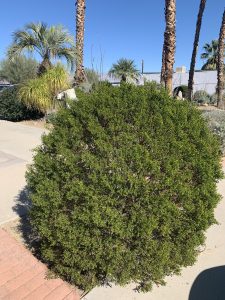
Weeding
I guess if there is any good thing about a really dry winter (there isn’t), it could be that weeds are absent, scarce or very small. Stay on top of weeding. Your efforts will pay off because in the mature, stable natural garden they are a nonissue.
Mulching/Top dress
A video workshop called “The Low Down Dirt on Mulch” will be posted on our YouTube channel starting March 6, 2021. Here’s the link: Low Down Dirt On Mulch. If you need to apply an imported top dress material before summer, you can do it now through April/May time. Bottom line advice: chunky mulch, i.e.; redwood 1/2” walk-on bark is best.
Feeding
Don’t assume that native plants will not appreciate a little TLC like watering, pruning, pest control, weeding and of course plant foods. Right now is the perfect time to apply an organic fertilizer, dry material sold in a bag. The three numbers (Nitrogen, Phosphorus, Potassium, N-P-K) on the bag will be quite small compared to commercial or chemical fertilizers. Organics are not as strong as chemical ferts, but in addition to feeding the plants they help the soil.
Rough up the soil surface about an inch deep with a three prong cultivator (good for the abs), apply the fertilizer as per instructions on the bag, toss some high quality mulch (optional) and water thoroughly, or better yet, time your feeding to happen just before a good rain. Sit back and watch the plants grow. They will thank you.
Troubleshooting – Varmints, Pests and Diseases
Natural gardens are quite resistant to insect pest problems, mainly because of the ecological balance you create by attracting and harboring beneficials. That said, injurious plant pests can get out of hand and you need to protect your plants.
Last month, we looked at the manzanita leaf gall aphid and ceanothus stem gall moth. We talked a little about gophers. By the way, the only humane way to get gophers out of your garden is to pray that the raptors will be successful or set traps that will kill them swiftly and instantly. No poisons, ever, please.
Springtime is when life starts anew. Insects included. If you suspect insect damage to a plant, you first have to determine from leaf damage – A. What kind of mouthparts do they have, chewing, rasping or sucking? B. Are the insects present or absent on inspection? C. Is the level of damage acceptable? D. What is the organic control using Best Management Practices, BMP?
A. What kind of mouthpart:
Chewing would include grasshoppers, caterpillars, some beetles. Often you don’t see the insects because they are mobile. Rasping would include snails and slugs (not technically insects). Sucking mouthparts come with tiny insects in vast numbers; aphids, mealybug, scale, white fly, and spider mite (not an insect).
B. Insects present or absent:
Insects with sucking mouthparts are always present on inspection. You might need a magnifying glass. Insects with chewing mouthparts are sometimes present if they are caterpillars, but may not be found with grasshoppers and beetles. Rasping, it’s rare to find a snail or slug in the act but look for slime trails on damaged leaves, and the mollusks hiding by day.
C. Is damage acceptable?:
We’re building habitat here. If the damage is not too bad, allow the beneficial insects, the birds, and lizards to take care of it. If populations are out of control and damage is extensive, we treat. Also, be aware that some insects transmit plant disease, so in those cases, protecting the plant becomes essential.
D. Control (over simplified):
Chewing – caterpillars, Bacillus thuringiensis (BT), a bacteria that basically gives them the stomach flu and is harmless to other insects, birds, etc. Note: If you want monarchs and other cool butterflies, do not use BT. Here we are talking about harmful caterpillars only, especially on vegetables, i.e.; cabbage looper caterpillars.
Rasping – I hear stale beer in bowls will attract snails and slugs. Also you can hunt them down at night with a flashlight in hand and destroy them how you see fit. The use of snail baits is debatable. Look for natural or organic products on the market.
Sucking – Organic Safer (horticultural) soaps or neem oil. Repeat application after 2-3 weeks to get subsequent generations. You can blast aphids to smithereens with a strong spray of hose water.
Send any specific questions to our GardenHelp email address, shown below.
Annual Wildflowers
We hope you are enjoying many flowers from the seed you sowed last fall. We have 4” pots of native wildflowers if you want to plant a few now, during their flowering season.
Adding New Plants
March is an ideal time to plant new plants in the garden. Come on over. We have a full line of natives plus many beautiful flowers in our display gardens. Every year is a super bloom year at Tree of Life. Our farm area called “La Finca” is busting out with organically grown vegetable transplants ready for you to take home. Spring is a great season.
Engage
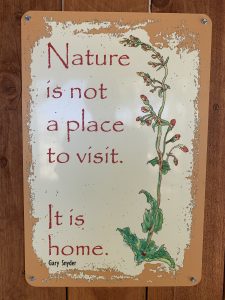 We recognize spring as the time of renewal. Just think, in these very days, one year ago, you could not find toilet paper on the shelves as the world was beginning to panic over a pandemic. 2020 was a tough year for everyone. Our hearts go out to anyone who lost loved ones to Covid-19, and to those who might have become seriously ill. We hope everything gets better. The disease was a game changer… still is. But as many are getting their vaccinations and the statistics are moving towards more favorable reports, we are ready to put the past behind and move forward. Ready for renewal.
We recognize spring as the time of renewal. Just think, in these very days, one year ago, you could not find toilet paper on the shelves as the world was beginning to panic over a pandemic. 2020 was a tough year for everyone. Our hearts go out to anyone who lost loved ones to Covid-19, and to those who might have become seriously ill. We hope everything gets better. The disease was a game changer… still is. But as many are getting their vaccinations and the statistics are moving towards more favorable reports, we are ready to put the past behind and move forward. Ready for renewal.
This is one reason I like hiking, or more reasonably put, walking, meandering, strolling, exploring, discovering. You’re always moving forward. An occasional glance behind will help with orientation. Stopping to rest or to take your bearings gives time for considering your situation. Following markers on the trail, or setting up a few new ones to prevent someone behind from getting lost connects you to others. Keen observation feeds the mind. And finishing the course gives you a true sense of accomplishment. But I think the main point is to keep moving forward. And stay on the right path.
Not only are we gonna make it, we are really makin’ it!
From the March Garden,
Mike Evans
Questions? Help is just one call or one email away. Call (949) 728-0685 or email (with pictures if you like) our special helpline: gardenhelp@californianativeplants.com
